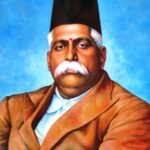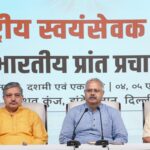
Ram Madhav
article by Ram Madhav, RSS Functionary

The biggest problem in Sino-Indian relations is the utter lack of ingenuity and innovativeness. Six decades after the formal engagement through Panchsheel and five decades after the bloody disengagement due to the war of 1962 the leaders of both the countries still struggle to come up with new and out of the box answers to the problems plaguing their relationship.
When there are no new ideas one would resort to symbolism and rituals. These rituals and symbolic actions are projected as the great new ideas to kick-start a new relationship. However there is nothing great nor new about these actions. They are the very same worn out and tried-tested-and-failed actions in the last several decades.
Panchsheel itself is one such ritual that successive Indian governments have unfailingly performed in the last five or more decades. Vice President Hamid Ansari will be visiting Beijing on 28 June to uphold India’s commitment to the ritual. The occasion is completion of six decades of the signing of the Panchsheel Agreement.
It was exactly six decades ago, on 28 June 1954, roughly two months after the formal signing of Panchsheel, that the Chinese Premier Chow En-lai visited India. He and Prime Minister Nehru had issued a historic statement on that day reaffirming their commitment to the five principles that were enshrined in the Panchsheel that “would lessen the tensions that exist in the world today and help in creating a climate of peace”.
What Exactly Was Panchsheel?
Contrary to public perception, or propaganda Panchsheel was actually an agreement between ‘Tibetan region of China and India’ on ‘Trade and intercourse’. It did include five principles like mutual respect, mutual non-aggression, mutual benefit, peaceful coexistence etc, but the very title of the Agreement itself was a big defeat to India.
The British had, at least from the Shimla Agreement of 1912 onwards till they left India, never conceded that Tibet was a part of China. Unfortunately one of the first foreign policy deviations of the Nehru Government was the signing of Panchsheel wherein India had formally called Tibetan region as ‘of China’.
Thus Panchsheel was signed as a treaty of peaceful coexistence over the obituary of Tibetan independence. That was why eminent parliamentarian Acharya Kripalani called the agreement as ‘born in sin’.
Rituals Continue
Panchsheel met its watery grave in just three months after its signing when the Chinese were found violating Indian borders in Ladakh area in late 1954. A formal death note was written by Mao a few months before the war of 1962 when he told Chow En-lai in a mischievous tone that what India and China should practise is not ‘peaceful coexistence’ but ‘armed coexistence’.
The war followed and ended in a huge humiliation and loss of territory to India. It left behind a massive border dispute which continues to haunt both the countries.
However all this didn’t seem to deter the Indian and to some extent the Chinese leadership in continuing with the deception of Panchsheel. History of Sino-Indian relations in the last five decades is replete with instances of violations of sovereignty, mutual animosity, attempts to upstage each other and general ill-will. Mostly the Chinese were on the wrong side of the so-called Five Principles of Peaceful Coexistence.
Yet the ritual continued through the decades and changing governments in India. Nehru to Narasimha Rao to Vajpayee continued this ritual of paying lip sympathy to Panchsheel during the bilateral visits.
“Only with coexistence can there be any existence” declared Indira Gandhi in 1983. Her son and the next Prime Minister of India Rajiv Gandhi expressed confidence in 1988 that “the five principles of peaceful coexistence provide the best way to handle relations between nations”. Narasimha Rao as Prime Minister declared in 1993 that “these principles remain as valid today as they were when they were drafted”.
While Vajpayee too was forced to continue this ritual, he made a significant difference by refusing to falsely credit China for following Panchsheel. He put extra emphasis on ‘mutual sensitivity to the concerns of each other’ and ‘respect for equality’.
New Framework
At a time when Beijing is celebrating the six decades of Panchsheel it is important to look at a new framework for Sino-Indian relations beyond Panchsheel. Vajpayee has laid some foundation for a renewed outlook by emphasising on sensitivity and equality. That can form the basis for the new framework.
The Chinese have a clever way of promoting their superiority and exclusivism. Sinologists describe it as Middle Kingdom syndrome. While Nehru wanted to take credit for Panchsheel, Chow En-lai told Nixon in 1973 that “actually the Five Principles were put forward by us, and Nehru agreed. But later on he didn’t implement them”
The Chinese side also brought in Myanmar – Burma at that time – and entered into a similar agreement with that country also on the same principles in 1954. Thus they made sure that Panchsheel doesn’t have any exclusivity in terms of their relationship with India.
For the Beijing event the Chinese Government has invited President of India as well as President of Myanmar. Gen. Thein Sein, the Myanmar President is going to be present along with the Vice President of India Hamid Ansari who is leading the Indian delegation.
Without any malice towards Vice President Ansari one would notice the downgrading of India’s participation in the Beijing event. Beijing was keen on having the President or Prime Minister at the event. But for once the South Block mandarins seemed to have done good homework in advising the Indian Government against sending either of them. The Foreign Minister Sushma Swaraj too decided to skip the event and chose to visit Dhaka around the same time sending a rather strong signal.
If Prime Minister Modi and President Xi Jinping, who is expected to visit India in September decide to depart from the Panchsheel framework and embark on a new relationship both countries would greatly benefit. Both leaders have that ability as both of them come from backgrounds that are markedly different from Nehruvian and Maoist ones. Both enjoy trust and confidence of the people of respective countries. Most importantly both are seen as out of the box leaders.
India and China can cooperate with each other on the principles of sovereign equality and mutual sensitivity. China has emerged today as an economic super power but it is exposed to serious internal and external threats. It is facing problems with almost all of its 13 neighbours. The fact that China spends more money on internal security than on external security speaks volumes about its internal vulnerability. That way while India is not that big an economic power as China is, its security apparatus is certainly better placed than China’s.
Modi and Jinping can chart a new course in Sino-Indians relations if they are prepared to unshackle themselves from ritualism and symbolism. Both have the ability to do that and the much needed support from the people.
-Ram Madhav, RSS
June 27, 2014







